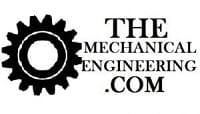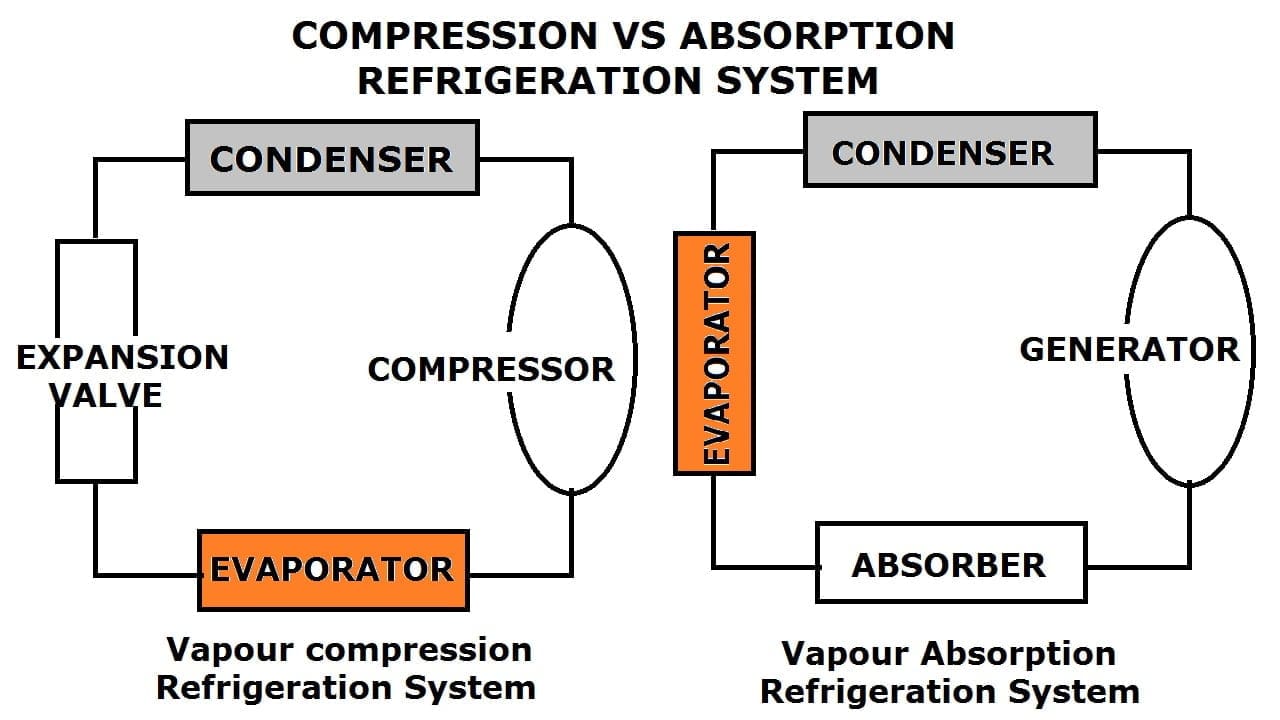Hello Everyone, In this article, we will study the Difference between Vapour compression and the Absorption Refrigeration System in detail. And at the end of the article, you will be able to download a PDF of this article.
Lets start,
What is Vapour compression Refrigeration System?
The Vapour compression Refrigeration System is a refrigeration system in which we use R12 as a refrigerant and this system needs high-grade energy (mechanical energy or Electrical Energy) for the operating compressor.
The working of the Compression refrigeration system in brief: The refrigerant is drawn from the evaporator and sends to the compressor, here it is compressed adiabatically to high temperature and high pressure. Now it is sent to the condenser for cooling at constant pressure.
After that, The high-refrigerant is expanded through an expansion valve, and here the temperature and pressure decrease. Now in the evaporator, it absorbs heat at constant pressure and cools the space. And further, the cycle is repeating.
Now come to Vapour Absorption Refrigeration System,
What is Vapour Absorption Refrigeration System?
The Vapour Absorption Refrigeration System is a refrigeration system in which we use ammonia (NH3) or water as a refrigerant and here Low-grade energy sources (waste heat from furnaces, exhaust steam) and Solar power used for running a vapor absorption system.
Here in the diagram you can see the components of both the refrigeration system.
Difference between Vapour compression and Absorption Refrigeration System:
I have listed more than 15 point on the Difference between Vapour compression and Absorption Refrigeration System:
| Vapour compression Refrigeration System | Vapour Absorption Refrigeration System |
| The Vapour compression refrigeration system has parts like Compressor, receiver, condenser, refrigerant control device, and evaporator. Whereas, | Vapour Absorption Refrigeration has Parts like condenser absorber, generator, rectifier, and evaporator. |
| Here when the operation is going it produces noise. | There is very less in noise or you can say it is quiet in operation. |
| The refrigerant we use here is Chlorofluorocarbons, Hydrocarbons, and Hydrochlorofluorocarbons. Or you can say R12 refrigerant is used. | In the Absorption system, we use refrigerant is Ammonia or water. |
| Here the charging of these refrigerants is very simple. Whereas | In this case, charging is very difficult. |
| The supply of energy is low. | Here the supply of energy is high. |
| The compression system occupies more space and It is less efficient. | The Absorption system occupies less space and It is more efficient comparatively the Compression refrigeration system. |
| Vapour compression refrigeration system required to operate by prime movers like electric Motor, Petrol engine or Diesel Engine. | But here It is required to operate by heat energy like kerosene oil, gas, or electric heater. |
| The compressor is used and The flow of gas depends upon the compressor only. Whereas | In the Absorption system, the flow of gas depends upon the generator’s working and Gravity. |
| The mechanical energy is supplied as input here. | The heat energy is supplied here as input. |
| Here the chances of wear and tear because the compression system has many moving parts. | Here the chances of wear and tear are very less because the Absorption system has not any moving parts. |
| Here the refrigerant is being compressed for working operation. | In the Absorption system, refrigerant is being absorbed and heated. |
| The operationg cost is high becasue here we compressor and it consumes more work. | The operationg cost is Less because of less heat energy is required. |
| The coefficient of Power (COP) is high in the compression system. | The coefficient of Power (COP) is low in the Absorption system. |
| Maintenance is more. | Less Maintenance. |
| The compressor system is not used for large capacity work as it is limited. Whereas | This system is used for large-capacity works. |
| The leakage chance is more because of high pressure. | The leakage chance is very less or negligible because of low pressure. |
Finally studied all the points in detail. If this article helps you then do not forget to share it with your friends and family. And I request you to check our other articles too.
Internal Resources:
- Automobile Engineering
- Manufacturing Technology
- Thermodynamics
- Theory of Machines
- Engineering Mechanics
- Fluid Mechanics and Machinery
References [External Links]
- Slide share: Compressor vs Absorption System PPT By Prasad Ghare
- Ecourseonline: Unit 2 Refrigeration System
- Researchgate.net




![Different Types of Measuring Tools and their Uses [Notes & PDF] Feature Image of Types of Measuring Tools](https://themechanicalengineering.com/wp-content/uploads/2023/01/Feature-Image-of-Types-of-Measuring-Tools-300x171.jpg)
![Steel: Properties, Different Types and Applications [Notes & PDF] Feature Image of Steel](https://themechanicalengineering.com/wp-content/uploads/2023/01/Feature-Image-of-Steel-300x168.jpg)

Discussion about this post